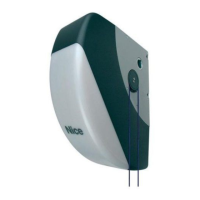ENGLISH – 17
7.2 LEVEL 1 PROGRAMMING (ON-OFF)
All the Level 1 functions are factory-set to “OFF” and can be modied at any time. To check the various functions, refer to “Table 8”.
7.2.1 Level 1 programming procedure
m
The user has maximum 10 seconds to press the buttons consecutively during the programming procedure, af-
ter which time the procedure terminates automatically and memorises the changes made up to then.
To perform Level 1 programming:
1. press and hold the
o
button until LED “L1” starts ashing
2. release the
o
button when LED “L1” starts ashing
3. press the
p
or
q
button to move the ashing LED to the LED associated with the function to be modied
4. press the
o
button to change the status of the function:
– short ash = OFF
– long ash = ON
5. wait 10 seconds (maximum time) to exit the programming mode.
l
To set other functions to “ON” or “OFF”, while the procedure is running, repeat points 2 and 3 during the phase
itself.
Table 8
LEVEL 1 FUNCTIONS (ON-OFF)
LED Function Description
L1 Automatic closing
Function ENABLED: after an opening manoeuvre there is a pause (equal to the set pause time), after which
the control unit automatically starts a closing manoeuvre. The pause time is set by default to 30 seconds.
Function NOT ENABLED: the system works in “semi-automatic” mode.
L2 Close after photo
Function ENABLED: the behaviour changes depending on whether the “Automatic Closing” function is
enabled or not.
When “Automatic closing” is not active: The door always reaches the fully open position (even if Photo is
disengaged beforehand). When Photo disengages, automatic closing is triggered with a 5-second pause.
When “Automatic Closing” is enabled: the opening manoeuvre stops immediately after the photocells have
disengaged. After 5 seconds, the gate will start closing automatically.
The “Close After Photo” function is always disabled in manoeuvres interrupted by a Stop command.
Function DISABLED: the pause time is that which has been programmed or automatic re-closing will not take
place if the function is disabled.
L3 Always Close
Function ENABLED: in the event of a blackout, even of short duration, if the control unit detects that the door
is open once the electricity is restored, it automatically starts a closing manoeuvre, preceded by a 3-second
pre-ashing sequence.
Function DISABLED: when the electricity is restored, the gate remains in the same position.
L4 Stand-by
Function ENABLED: 1 minute after the completion of the manoeuvre, the control unit switches off the
BlueBUS output (and, therefore, the devices) and all LEDs, with the exception of the BlueBUS LED, which
ashes more slowly. When the control unit receives a command, it restores full operation.
Function DISABLED: there will be no reduction in consumption.
This function is useful, in particular, during operation with the back-up battery.
L5 Long reversal
Function ENABLED: once the STOP device or the force limiter intervenes, the movement is reversed up to the
maximum opening or closing position
Function DISABLED: the reversal is short (roughly 6in (15cm)).
L6 Pre-ashing
Function ENABLED: a 3-second pause can be added between the switching on of the warning light and the
start of the manoeuvre, to warn the user in advance of a potentially dangerous situation.
Function DISABLED: the signalling of the warning light coincides with the start of the manoeuvre.
L7 Sensitivity
Function ENABLED: allows for considerably increasing the motor’s sensitivity in detecting obstacles. If used
to aid impact force detection, the “Speed” and “Motor force” parameters in the Level 2 menu must also be
adjusted.
Function DISABLED: the motor’s obstacle detection sensitivity is unchanged.
L8 Type of door
Function ENABLED: allows for selecting the type of door to be moved: Light or Heavy. If enabled, the control
unit is optimised to move Heavy doors.
Function DISABLED: the control unit is optimised to move smaller-size doors.
l
During normal operation, in other words when no manoeuvre is under way, LEDs “L1 ... L8“” are on or off de-
pending on the status of the respective function; for example, “L1” is lit when the “Automatic Closing” function
is enabled. During the manoeuvre, LEDs “L1 ... L8” ash to signal the force required to move the door at that
time. If “L1” ashes, the force required is low and so forth, until LED “L8” ashes to signal the maximum force.
There is no relation between the force level indicated by the LEDs during the movement (which is an absolute
value) and the level indicated by the LEDs during the force (which is a relative value) programming phase. See
“L5” and “L6” in “Table 9”.

